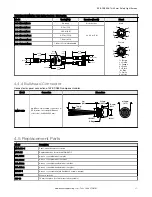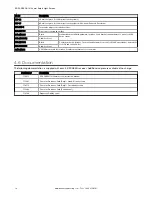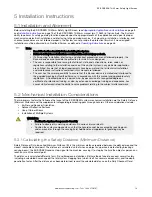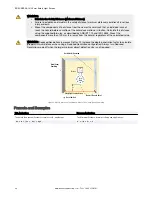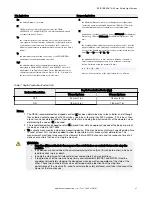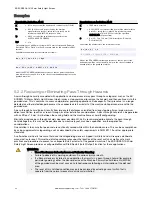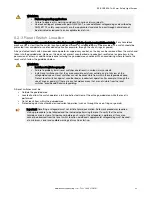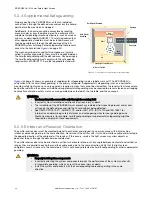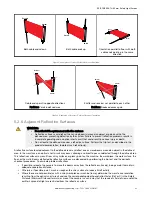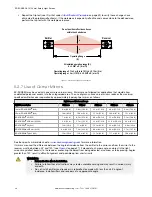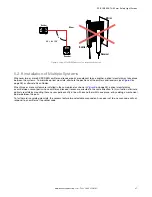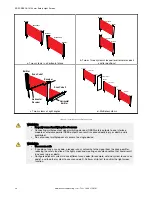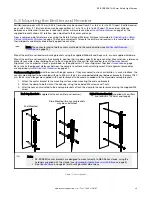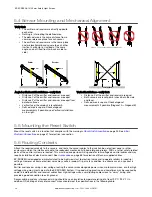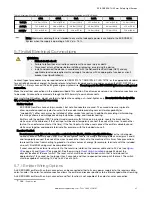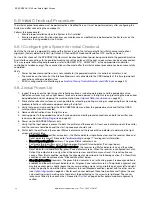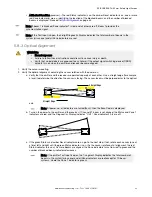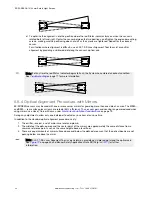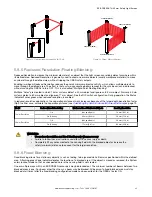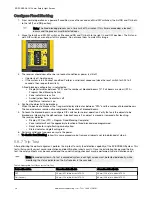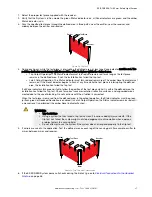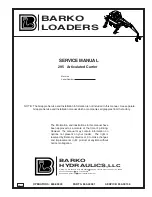
Examples
Example: U.S. Applications, Model
K
= 63 in. per second (the hand speed constant set by OSHA)
Ts
= 0.32 (0.250 second is specified by the machine
manufacturer; plus 20% safety factor; plus 20 ms for
interface module IM-T-9A response time)
Tr
= 0.023 seconds (the specified response time of an
SLSP14-600 EZ-SCREEN)
Dpf
= 3 in
Our example uses a 600 mm system with 14 mm resolution and Reduced
Resolution ON, so Dpf is 3 inches. Response time for this example is 0.023
seconds.
Substitute the numbers into the formula as follows:
Ds = K × ( Ts + Tr ) + Dpf
Ds = 63 × (0.32 + 0.023) + 3 = 24.6 in
Mount the EZ-SCREEN emitter and receiver so that no part of the defined
area will be closer than 24.6 in. to the closest reachable hazard point on the
guarded machine.
Example: European Applications, Model
K
= 1600 mm per second
T
= 0.343 (0.250 second specified by machine manufacturer;
plus 20% safety factor; plus 20 ms interface module
response time), plus 0.023 seconds (the specified
SLSP14-600 response time)
C
= 8 x (30 - 14) = 128 mm (14 mm resolution, Reduced
Resolution ON)
Substitute the numbers into the formula as follows:
S = (K × T ) + C
S = (1600 × 0.343) + 128 = 676.8 mm
Mount the EZ-SCREEN emitter and receiver so that no part of the
defined area will be closer than 676.8 mm to the closest reachable
hazard point on the guarded machine.
5.2.2 Reducing or Eliminating Pass-Through Hazards
A
pass-through
hazard is associated with applications where personnel may pass through a safeguard, such as the EZ-
SCREEN 14/30mm Safety Light Screen (which issues a stop command to remove the hazard), and then continues into the
guarded area. This is common in access and perimeter guarding applications. Subsequently, their presence is no longer
detected, and the related danger becomes the unexpected start or restart of the machine while personnel are within the
guarded area.
A pass-through hazard typically results from large safety distances calculated from long stopping times, large minimum
object sensitivities, reach-over, reach-through, or other installation considerations. A pass-through hazard can be generated
with as little as 75 mm (3 in) between the sensing field and the machine frame or hard (fixed) guarding.
Eliminate or reduce pass-through hazards whenever possible. While it is recommended to eliminate the pass-through
hazard altogether, this may not be possible due to machine layout, machine capabilities, or other application
considerations.
One solution is to ensure that personnel are continually sensed while within the hazardous area. This can be accomplished
by using supplemental safeguarding, such as described by the safety requirements in ANSI B11.19 or other appropriate
standards.
An alternative method is to ensure that once the safeguarding device is tripped it will latch and will require a deliberate
manual action to reset. This method of safeguarding relies upon the location of the reset switch as well as safe work
practices and procedures to prevent an unexpected start or restart of the guarded machine. The EZ-SCREEN 14/30mm
Safety Light Screen provides a configurable Manual Start/Restart (Latch Output) function for these applications.
WARNING:
• Use of the Banner device for Access or Perimeter Guarding
• Failure to observe this warning could result in serious injury or death.
• If a Banner device is installed in an application that results in a pass-through hazard (for example,
perimeter guarding), either the Banner device or the Machine Primary Control Elements (MPCEs)
of the guarded machine must cause a Latched response following an interruption of the defined
area.
• The reset of this Latched condition may only be achieved by actuating a reset switch that is
separate from the normal means of machine cycle initiation.
EZ-SCREEN
®
14/30 mm Safety Light Screen
22
www.bannerengineering.com - Tel: + 1 888 373 6767










